Strategic Analysis of Coles Supermarket: Market, SWOT, and Strategy
VerifiedAdded on 2022/11/10
|18
|3042
|137
Report
AI Summary
This report offers a comprehensive strategic analysis of Coles Supermarket within the Australian retail industry. It begins with an executive summary and delves into market size and trends, highlighting the company's position within an oligopolistic market dominated by major players like Coles and Woolworths. The report assesses Coles' corporate and financial performance, including revenue, customer satisfaction, and growth strategies. A detailed SWOT analysis examines the company's strengths, weaknesses, opportunities, and threats, considering factors like government regulations, economic conditions, and competitor analysis. The five forces model is applied to understand the impact on Coles. The analysis also covers competitive advantages, resources, and capabilities. Strategic options and recommendations are proposed, focusing on maintaining competitive edge, expanding operations, and adapting to market changes. The report concludes with a summary of key findings and insights into Coles' future prospects.

Running Head: MANAGEMENT 0
STRATEGIC MANAGEMENT
STRATEGIC MANAGEMENT
Paraphrase This Document
Need a fresh take? Get an instant paraphrase of this document with our AI Paraphraser
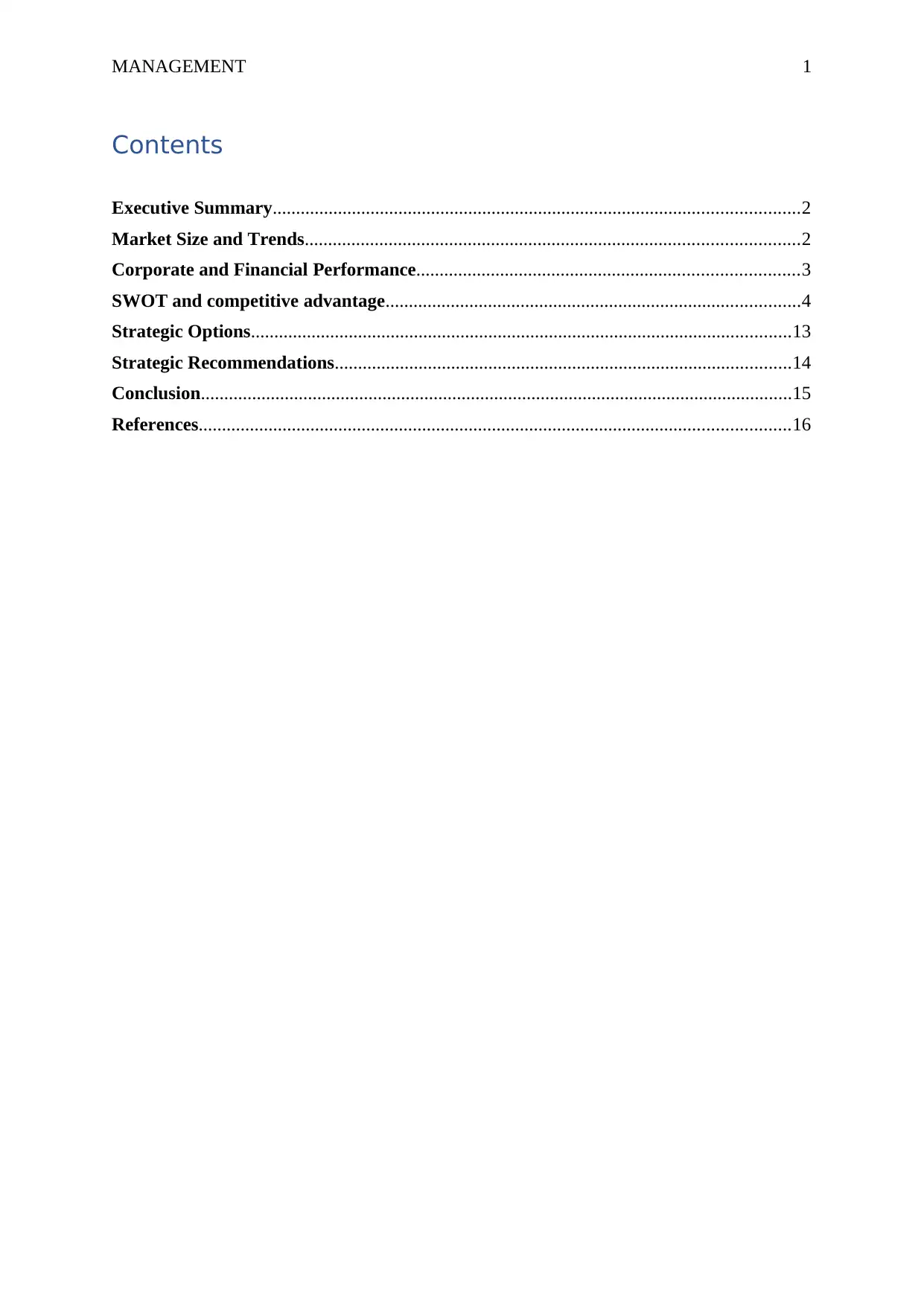
MANAGEMENT 1
Contents
Executive Summary.................................................................................................................2
Market Size and Trends..........................................................................................................2
Corporate and Financial Performance..................................................................................3
SWOT and competitive advantage.........................................................................................4
Strategic Options....................................................................................................................13
Strategic Recommendations..................................................................................................14
Conclusion...............................................................................................................................15
References...............................................................................................................................16
Contents
Executive Summary.................................................................................................................2
Market Size and Trends..........................................................................................................2
Corporate and Financial Performance..................................................................................3
SWOT and competitive advantage.........................................................................................4
Strategic Options....................................................................................................................13
Strategic Recommendations..................................................................................................14
Conclusion...............................................................................................................................15
References...............................................................................................................................16
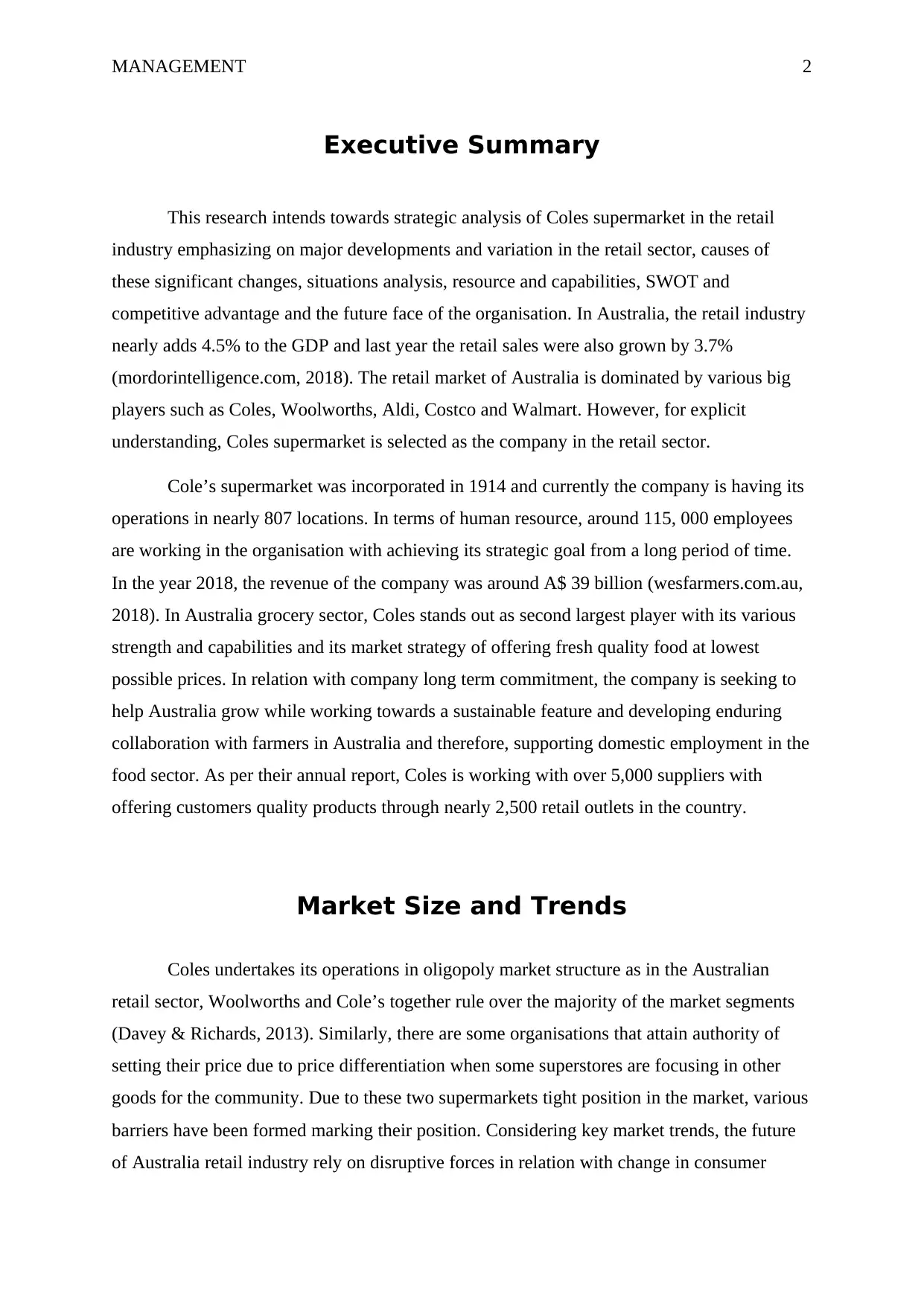
MANAGEMENT 2
Executive Summary
This research intends towards strategic analysis of Coles supermarket in the retail
industry emphasizing on major developments and variation in the retail sector, causes of
these significant changes, situations analysis, resource and capabilities, SWOT and
competitive advantage and the future face of the organisation. In Australia, the retail industry
nearly adds 4.5% to the GDP and last year the retail sales were also grown by 3.7%
(mordorintelligence.com, 2018). The retail market of Australia is dominated by various big
players such as Coles, Woolworths, Aldi, Costco and Walmart. However, for explicit
understanding, Coles supermarket is selected as the company in the retail sector.
Cole’s supermarket was incorporated in 1914 and currently the company is having its
operations in nearly 807 locations. In terms of human resource, around 115, 000 employees
are working in the organisation with achieving its strategic goal from a long period of time.
In the year 2018, the revenue of the company was around A$ 39 billion (wesfarmers.com.au,
2018). In Australia grocery sector, Coles stands out as second largest player with its various
strength and capabilities and its market strategy of offering fresh quality food at lowest
possible prices. In relation with company long term commitment, the company is seeking to
help Australia grow while working towards a sustainable feature and developing enduring
collaboration with farmers in Australia and therefore, supporting domestic employment in the
food sector. As per their annual report, Coles is working with over 5,000 suppliers with
offering customers quality products through nearly 2,500 retail outlets in the country.
Market Size and Trends
Coles undertakes its operations in oligopoly market structure as in the Australian
retail sector, Woolworths and Cole’s together rule over the majority of the market segments
(Davey & Richards, 2013). Similarly, there are some organisations that attain authority of
setting their price due to price differentiation when some superstores are focusing in other
goods for the community. Due to these two supermarkets tight position in the market, various
barriers have been formed marking their position. Considering key market trends, the future
of Australia retail industry rely on disruptive forces in relation with change in consumer
Executive Summary
This research intends towards strategic analysis of Coles supermarket in the retail
industry emphasizing on major developments and variation in the retail sector, causes of
these significant changes, situations analysis, resource and capabilities, SWOT and
competitive advantage and the future face of the organisation. In Australia, the retail industry
nearly adds 4.5% to the GDP and last year the retail sales were also grown by 3.7%
(mordorintelligence.com, 2018). The retail market of Australia is dominated by various big
players such as Coles, Woolworths, Aldi, Costco and Walmart. However, for explicit
understanding, Coles supermarket is selected as the company in the retail sector.
Cole’s supermarket was incorporated in 1914 and currently the company is having its
operations in nearly 807 locations. In terms of human resource, around 115, 000 employees
are working in the organisation with achieving its strategic goal from a long period of time.
In the year 2018, the revenue of the company was around A$ 39 billion (wesfarmers.com.au,
2018). In Australia grocery sector, Coles stands out as second largest player with its various
strength and capabilities and its market strategy of offering fresh quality food at lowest
possible prices. In relation with company long term commitment, the company is seeking to
help Australia grow while working towards a sustainable feature and developing enduring
collaboration with farmers in Australia and therefore, supporting domestic employment in the
food sector. As per their annual report, Coles is working with over 5,000 suppliers with
offering customers quality products through nearly 2,500 retail outlets in the country.
Market Size and Trends
Coles undertakes its operations in oligopoly market structure as in the Australian
retail sector, Woolworths and Cole’s together rule over the majority of the market segments
(Davey & Richards, 2013). Similarly, there are some organisations that attain authority of
setting their price due to price differentiation when some superstores are focusing in other
goods for the community. Due to these two supermarkets tight position in the market, various
barriers have been formed marking their position. Considering key market trends, the future
of Australia retail industry rely on disruptive forces in relation with change in consumer
⊘ This is a preview!⊘
Do you want full access?
Subscribe today to unlock all pages.

Trusted by 1+ million students worldwide
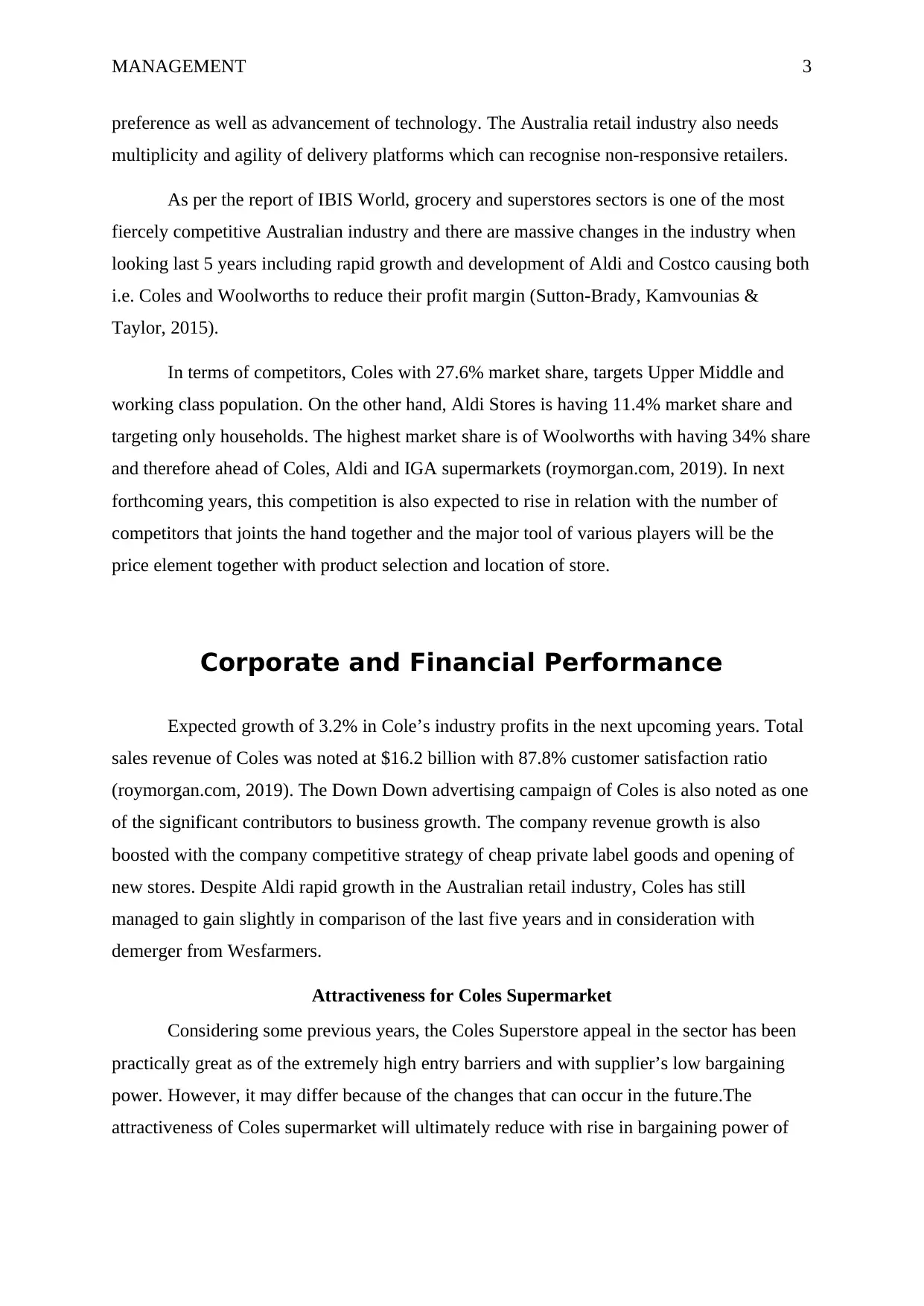
MANAGEMENT 3
preference as well as advancement of technology. The Australia retail industry also needs
multiplicity and agility of delivery platforms which can recognise non-responsive retailers.
As per the report of IBIS World, grocery and superstores sectors is one of the most
fiercely competitive Australian industry and there are massive changes in the industry when
looking last 5 years including rapid growth and development of Aldi and Costco causing both
i.e. Coles and Woolworths to reduce their profit margin (Sutton-Brady, Kamvounias &
Taylor, 2015).
In terms of competitors, Coles with 27.6% market share, targets Upper Middle and
working class population. On the other hand, Aldi Stores is having 11.4% market share and
targeting only households. The highest market share is of Woolworths with having 34% share
and therefore ahead of Coles, Aldi and IGA supermarkets (roymorgan.com, 2019). In next
forthcoming years, this competition is also expected to rise in relation with the number of
competitors that joints the hand together and the major tool of various players will be the
price element together with product selection and location of store.
Corporate and Financial Performance
Expected growth of 3.2% in Cole’s industry profits in the next upcoming years. Total
sales revenue of Coles was noted at $16.2 billion with 87.8% customer satisfaction ratio
(roymorgan.com, 2019). The Down Down advertising campaign of Coles is also noted as one
of the significant contributors to business growth. The company revenue growth is also
boosted with the company competitive strategy of cheap private label goods and opening of
new stores. Despite Aldi rapid growth in the Australian retail industry, Coles has still
managed to gain slightly in comparison of the last five years and in consideration with
demerger from Wesfarmers.
Attractiveness for Coles Supermarket
Considering some previous years, the Coles Superstore appeal in the sector has been
practically great as of the extremely high entry barriers and with supplier’s low bargaining
power. However, it may differ because of the changes that can occur in the future.The
attractiveness of Coles supermarket will ultimately reduce with rise in bargaining power of
preference as well as advancement of technology. The Australia retail industry also needs
multiplicity and agility of delivery platforms which can recognise non-responsive retailers.
As per the report of IBIS World, grocery and superstores sectors is one of the most
fiercely competitive Australian industry and there are massive changes in the industry when
looking last 5 years including rapid growth and development of Aldi and Costco causing both
i.e. Coles and Woolworths to reduce their profit margin (Sutton-Brady, Kamvounias &
Taylor, 2015).
In terms of competitors, Coles with 27.6% market share, targets Upper Middle and
working class population. On the other hand, Aldi Stores is having 11.4% market share and
targeting only households. The highest market share is of Woolworths with having 34% share
and therefore ahead of Coles, Aldi and IGA supermarkets (roymorgan.com, 2019). In next
forthcoming years, this competition is also expected to rise in relation with the number of
competitors that joints the hand together and the major tool of various players will be the
price element together with product selection and location of store.
Corporate and Financial Performance
Expected growth of 3.2% in Cole’s industry profits in the next upcoming years. Total
sales revenue of Coles was noted at $16.2 billion with 87.8% customer satisfaction ratio
(roymorgan.com, 2019). The Down Down advertising campaign of Coles is also noted as one
of the significant contributors to business growth. The company revenue growth is also
boosted with the company competitive strategy of cheap private label goods and opening of
new stores. Despite Aldi rapid growth in the Australian retail industry, Coles has still
managed to gain slightly in comparison of the last five years and in consideration with
demerger from Wesfarmers.
Attractiveness for Coles Supermarket
Considering some previous years, the Coles Superstore appeal in the sector has been
practically great as of the extremely high entry barriers and with supplier’s low bargaining
power. However, it may differ because of the changes that can occur in the future.The
attractiveness of Coles supermarket will ultimately reduce with rise in bargaining power of
Paraphrase This Document
Need a fresh take? Get an instant paraphrase of this document with our AI Paraphraser
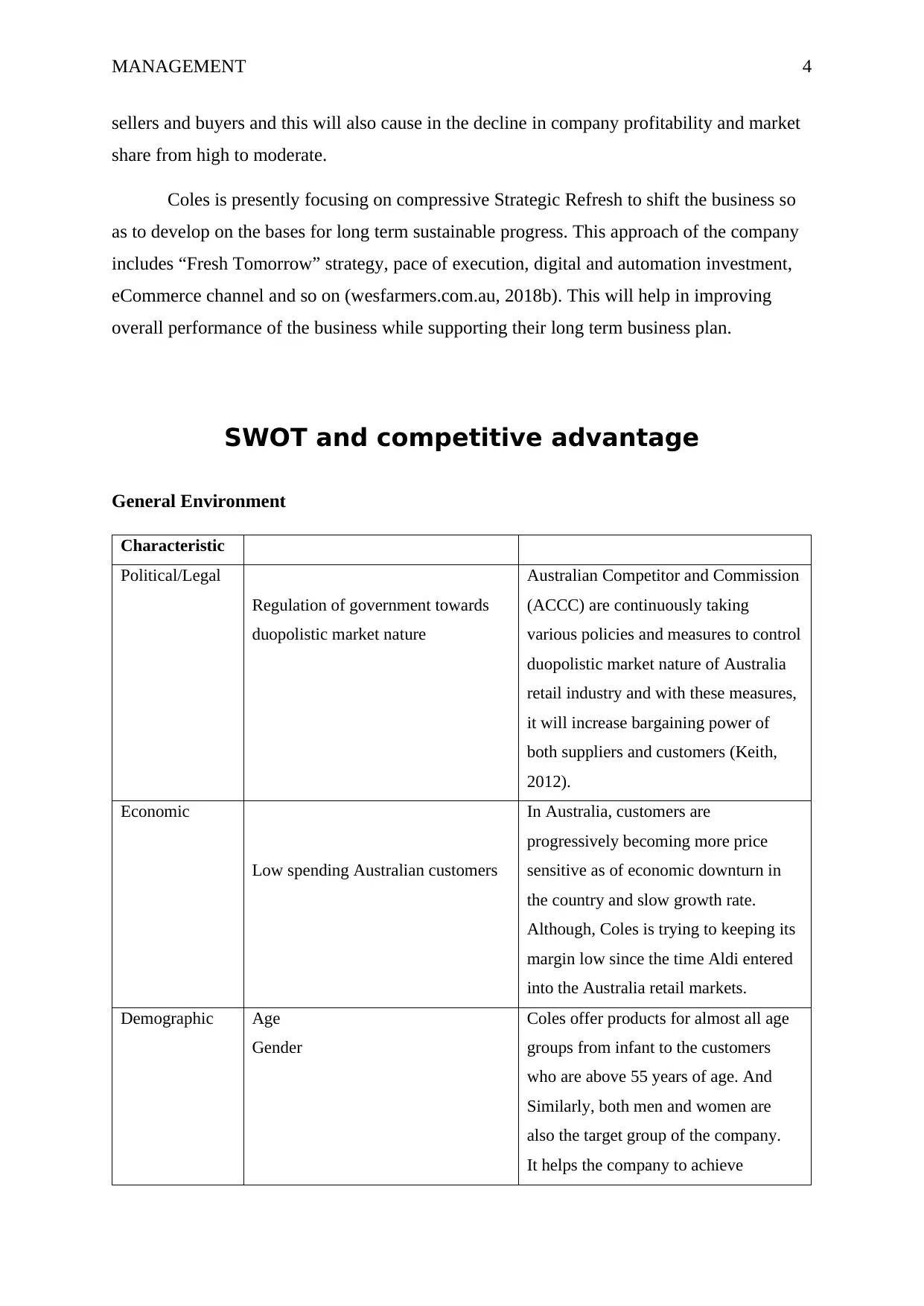
MANAGEMENT 4
sellers and buyers and this will also cause in the decline in company profitability and market
share from high to moderate.
Coles is presently focusing on compressive Strategic Refresh to shift the business so
as to develop on the bases for long term sustainable progress. This approach of the company
includes “Fresh Tomorrow” strategy, pace of execution, digital and automation investment,
eCommerce channel and so on (wesfarmers.com.au, 2018b). This will help in improving
overall performance of the business while supporting their long term business plan.
SWOT and competitive advantage
General Environment
Characteristic
Political/Legal
Regulation of government towards
duopolistic market nature
Australian Competitor and Commission
(ACCC) are continuously taking
various policies and measures to control
duopolistic market nature of Australia
retail industry and with these measures,
it will increase bargaining power of
both suppliers and customers (Keith,
2012).
Economic
Low spending Australian customers
In Australia, customers are
progressively becoming more price
sensitive as of economic downturn in
the country and slow growth rate.
Although, Coles is trying to keeping its
margin low since the time Aldi entered
into the Australia retail markets.
Demographic Age
Gender
Coles offer products for almost all age
groups from infant to the customers
who are above 55 years of age. And
Similarly, both men and women are
also the target group of the company.
It helps the company to achieve
sellers and buyers and this will also cause in the decline in company profitability and market
share from high to moderate.
Coles is presently focusing on compressive Strategic Refresh to shift the business so
as to develop on the bases for long term sustainable progress. This approach of the company
includes “Fresh Tomorrow” strategy, pace of execution, digital and automation investment,
eCommerce channel and so on (wesfarmers.com.au, 2018b). This will help in improving
overall performance of the business while supporting their long term business plan.
SWOT and competitive advantage
General Environment
Characteristic
Political/Legal
Regulation of government towards
duopolistic market nature
Australian Competitor and Commission
(ACCC) are continuously taking
various policies and measures to control
duopolistic market nature of Australia
retail industry and with these measures,
it will increase bargaining power of
both suppliers and customers (Keith,
2012).
Economic
Low spending Australian customers
In Australia, customers are
progressively becoming more price
sensitive as of economic downturn in
the country and slow growth rate.
Although, Coles is trying to keeping its
margin low since the time Aldi entered
into the Australia retail markets.
Demographic Age
Gender
Coles offer products for almost all age
groups from infant to the customers
who are above 55 years of age. And
Similarly, both men and women are
also the target group of the company.
It helps the company to achieve
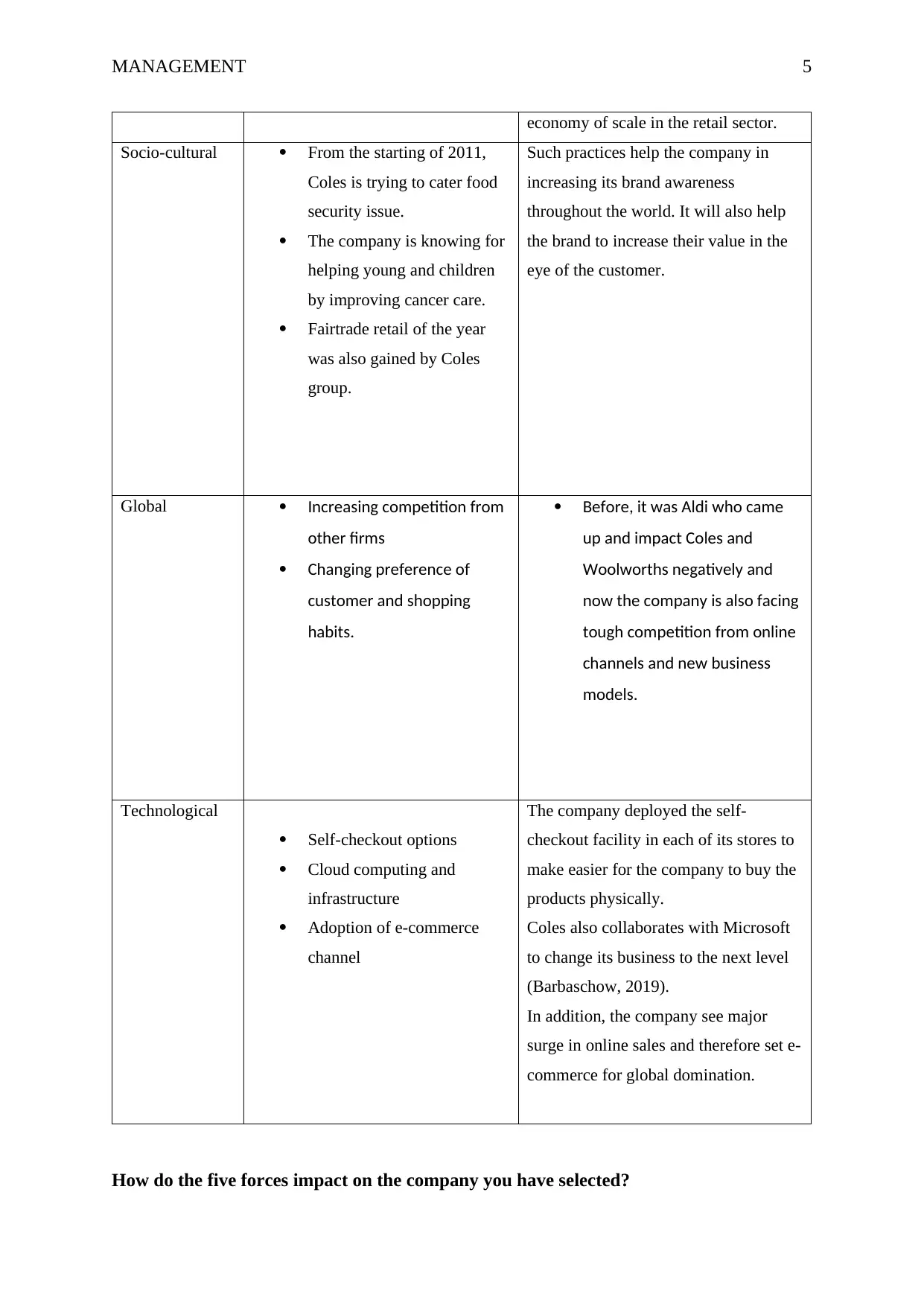
MANAGEMENT 5
economy of scale in the retail sector.
Socio-cultural From the starting of 2011,
Coles is trying to cater food
security issue.
The company is knowing for
helping young and children
by improving cancer care.
Fairtrade retail of the year
was also gained by Coles
group.
Such practices help the company in
increasing its brand awareness
throughout the world. It will also help
the brand to increase their value in the
eye of the customer.
Global Increasing competition from
other firms
Changing preference of
customer and shopping
habits.
Before, it was Aldi who came
up and impact Coles and
Woolworths negatively and
now the company is also facing
tough competition from online
channels and new business
models.
Technological
Self-checkout options
Cloud computing and
infrastructure
Adoption of e-commerce
channel
The company deployed the self-
checkout facility in each of its stores to
make easier for the company to buy the
products physically.
Coles also collaborates with Microsoft
to change its business to the next level
(Barbaschow, 2019).
In addition, the company see major
surge in online sales and therefore set e-
commerce for global domination.
How do the five forces impact on the company you have selected?
economy of scale in the retail sector.
Socio-cultural From the starting of 2011,
Coles is trying to cater food
security issue.
The company is knowing for
helping young and children
by improving cancer care.
Fairtrade retail of the year
was also gained by Coles
group.
Such practices help the company in
increasing its brand awareness
throughout the world. It will also help
the brand to increase their value in the
eye of the customer.
Global Increasing competition from
other firms
Changing preference of
customer and shopping
habits.
Before, it was Aldi who came
up and impact Coles and
Woolworths negatively and
now the company is also facing
tough competition from online
channels and new business
models.
Technological
Self-checkout options
Cloud computing and
infrastructure
Adoption of e-commerce
channel
The company deployed the self-
checkout facility in each of its stores to
make easier for the company to buy the
products physically.
Coles also collaborates with Microsoft
to change its business to the next level
(Barbaschow, 2019).
In addition, the company see major
surge in online sales and therefore set e-
commerce for global domination.
How do the five forces impact on the company you have selected?
⊘ This is a preview!⊘
Do you want full access?
Subscribe today to unlock all pages.

Trusted by 1+ million students worldwide
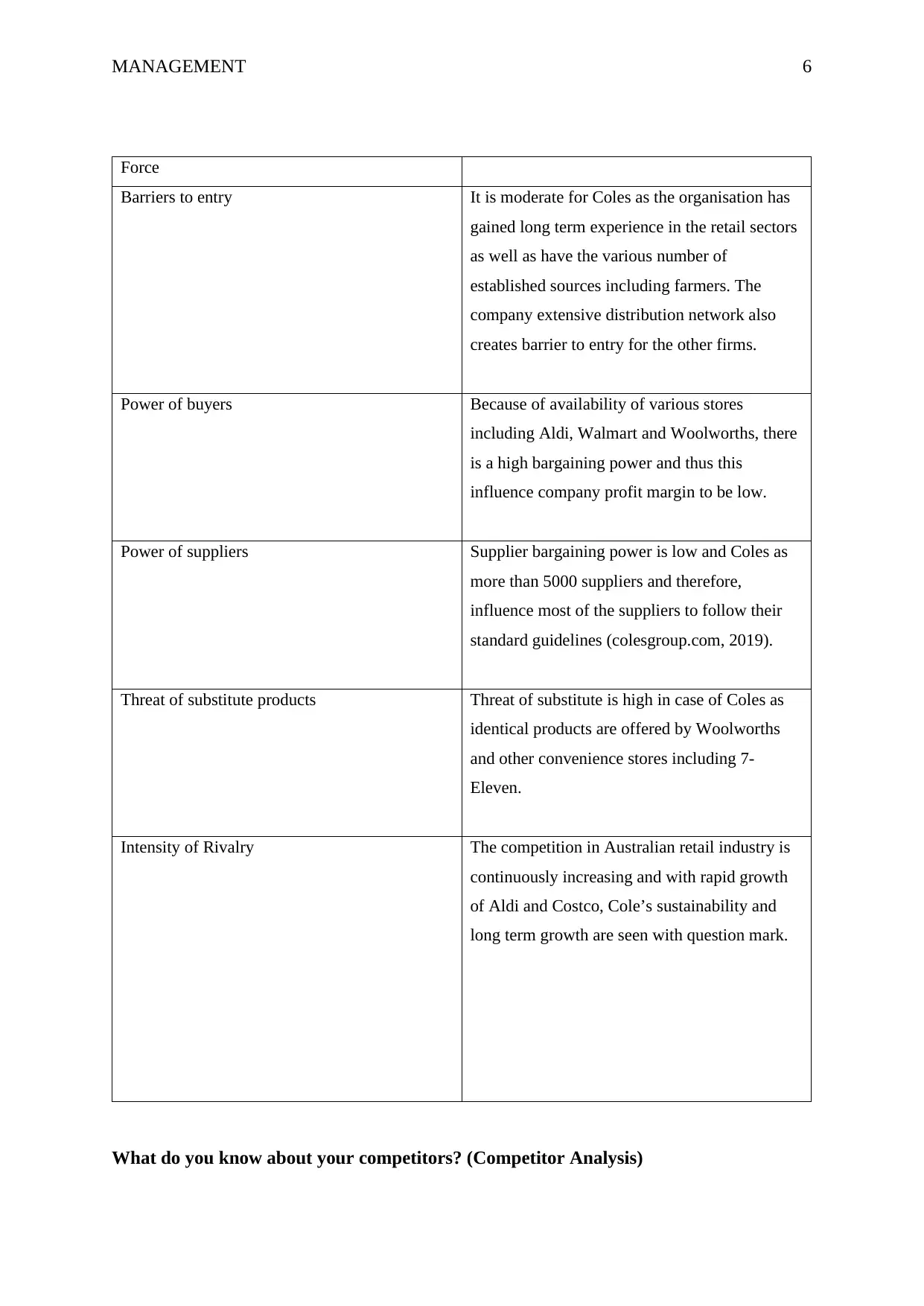
MANAGEMENT 6
Force
Barriers to entry It is moderate for Coles as the organisation has
gained long term experience in the retail sectors
as well as have the various number of
established sources including farmers. The
company extensive distribution network also
creates barrier to entry for the other firms.
Power of buyers Because of availability of various stores
including Aldi, Walmart and Woolworths, there
is a high bargaining power and thus this
influence company profit margin to be low.
Power of suppliers Supplier bargaining power is low and Coles as
more than 5000 suppliers and therefore,
influence most of the suppliers to follow their
standard guidelines (colesgroup.com, 2019).
Threat of substitute products Threat of substitute is high in case of Coles as
identical products are offered by Woolworths
and other convenience stores including 7-
Eleven.
Intensity of Rivalry The competition in Australian retail industry is
continuously increasing and with rapid growth
of Aldi and Costco, Cole’s sustainability and
long term growth are seen with question mark.
What do you know about your competitors? (Competitor Analysis)
Force
Barriers to entry It is moderate for Coles as the organisation has
gained long term experience in the retail sectors
as well as have the various number of
established sources including farmers. The
company extensive distribution network also
creates barrier to entry for the other firms.
Power of buyers Because of availability of various stores
including Aldi, Walmart and Woolworths, there
is a high bargaining power and thus this
influence company profit margin to be low.
Power of suppliers Supplier bargaining power is low and Coles as
more than 5000 suppliers and therefore,
influence most of the suppliers to follow their
standard guidelines (colesgroup.com, 2019).
Threat of substitute products Threat of substitute is high in case of Coles as
identical products are offered by Woolworths
and other convenience stores including 7-
Eleven.
Intensity of Rivalry The competition in Australian retail industry is
continuously increasing and with rapid growth
of Aldi and Costco, Cole’s sustainability and
long term growth are seen with question mark.
What do you know about your competitors? (Competitor Analysis)
Paraphrase This Document
Need a fresh take? Get an instant paraphrase of this document with our AI Paraphraser
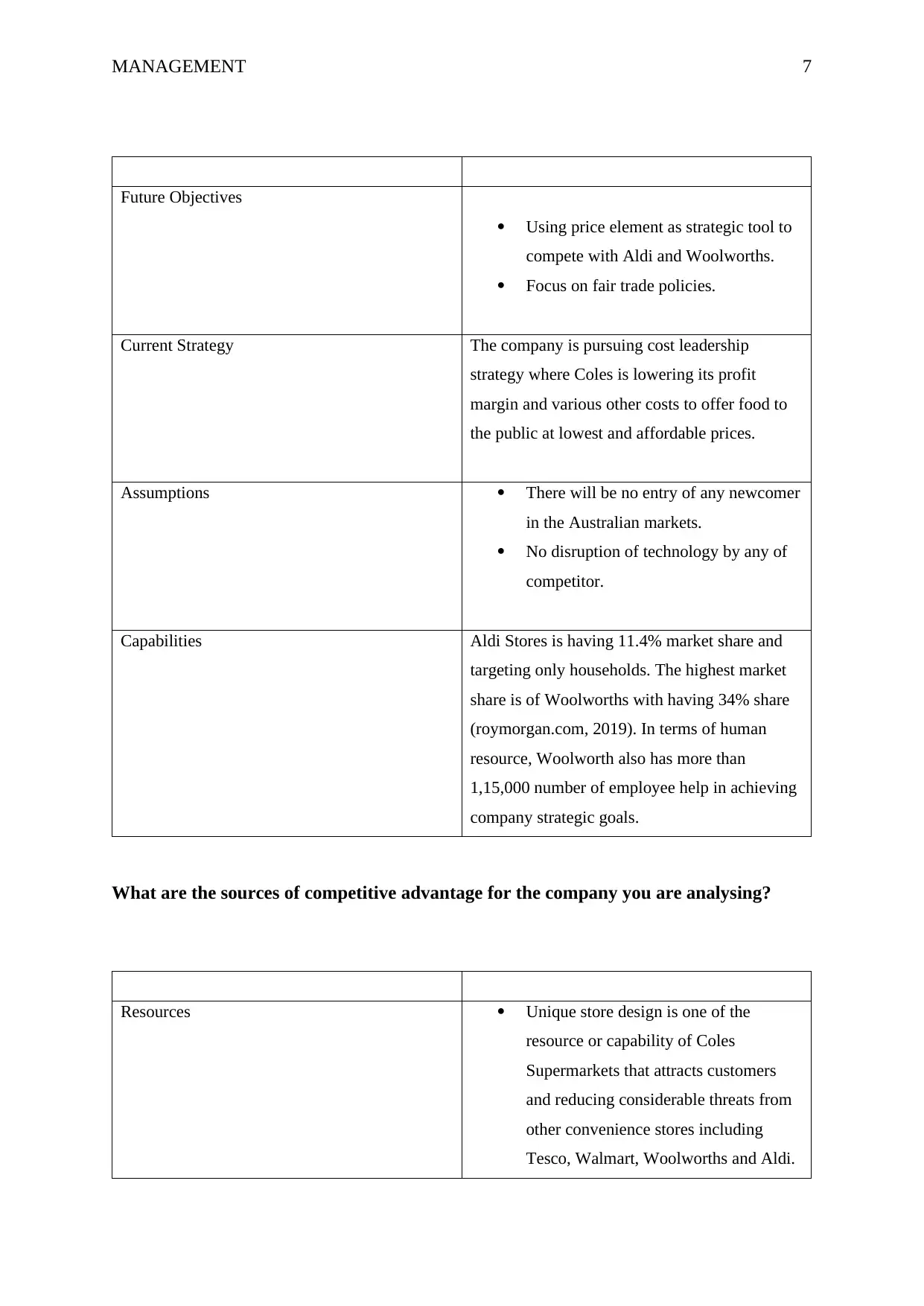
MANAGEMENT 7
Future Objectives
Using price element as strategic tool to
compete with Aldi and Woolworths.
Focus on fair trade policies.
Current Strategy The company is pursuing cost leadership
strategy where Coles is lowering its profit
margin and various other costs to offer food to
the public at lowest and affordable prices.
Assumptions There will be no entry of any newcomer
in the Australian markets.
No disruption of technology by any of
competitor.
Capabilities Aldi Stores is having 11.4% market share and
targeting only households. The highest market
share is of Woolworths with having 34% share
(roymorgan.com, 2019). In terms of human
resource, Woolworth also has more than
1,15,000 number of employee help in achieving
company strategic goals.
What are the sources of competitive advantage for the company you are analysing?
Resources Unique store design is one of the
resource or capability of Coles
Supermarkets that attracts customers
and reducing considerable threats from
other convenience stores including
Tesco, Walmart, Woolworths and Aldi.
Future Objectives
Using price element as strategic tool to
compete with Aldi and Woolworths.
Focus on fair trade policies.
Current Strategy The company is pursuing cost leadership
strategy where Coles is lowering its profit
margin and various other costs to offer food to
the public at lowest and affordable prices.
Assumptions There will be no entry of any newcomer
in the Australian markets.
No disruption of technology by any of
competitor.
Capabilities Aldi Stores is having 11.4% market share and
targeting only households. The highest market
share is of Woolworths with having 34% share
(roymorgan.com, 2019). In terms of human
resource, Woolworth also has more than
1,15,000 number of employee help in achieving
company strategic goals.
What are the sources of competitive advantage for the company you are analysing?
Resources Unique store design is one of the
resource or capability of Coles
Supermarkets that attracts customers
and reducing considerable threats from
other convenience stores including
Tesco, Walmart, Woolworths and Aldi.
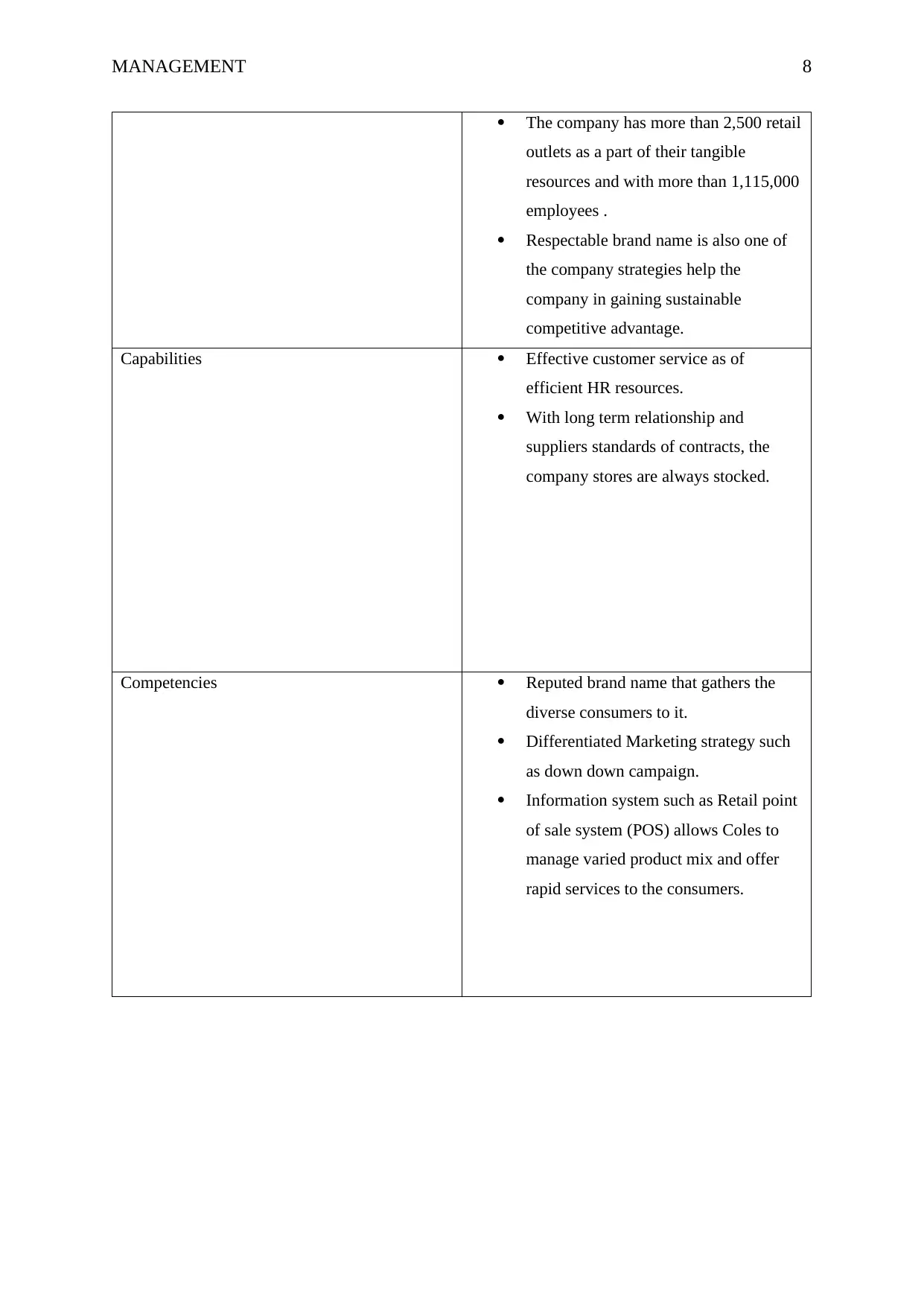
MANAGEMENT 8
The company has more than 2,500 retail
outlets as a part of their tangible
resources and with more than 1,115,000
employees .
Respectable brand name is also one of
the company strategies help the
company in gaining sustainable
competitive advantage.
Capabilities Effective customer service as of
efficient HR resources.
With long term relationship and
suppliers standards of contracts, the
company stores are always stocked.
Competencies Reputed brand name that gathers the
diverse consumers to it.
Differentiated Marketing strategy such
as down down campaign.
Information system such as Retail point
of sale system (POS) allows Coles to
manage varied product mix and offer
rapid services to the consumers.
The company has more than 2,500 retail
outlets as a part of their tangible
resources and with more than 1,115,000
employees .
Respectable brand name is also one of
the company strategies help the
company in gaining sustainable
competitive advantage.
Capabilities Effective customer service as of
efficient HR resources.
With long term relationship and
suppliers standards of contracts, the
company stores are always stocked.
Competencies Reputed brand name that gathers the
diverse consumers to it.
Differentiated Marketing strategy such
as down down campaign.
Information system such as Retail point
of sale system (POS) allows Coles to
manage varied product mix and offer
rapid services to the consumers.
⊘ This is a preview!⊘
Do you want full access?
Subscribe today to unlock all pages.

Trusted by 1+ million students worldwide
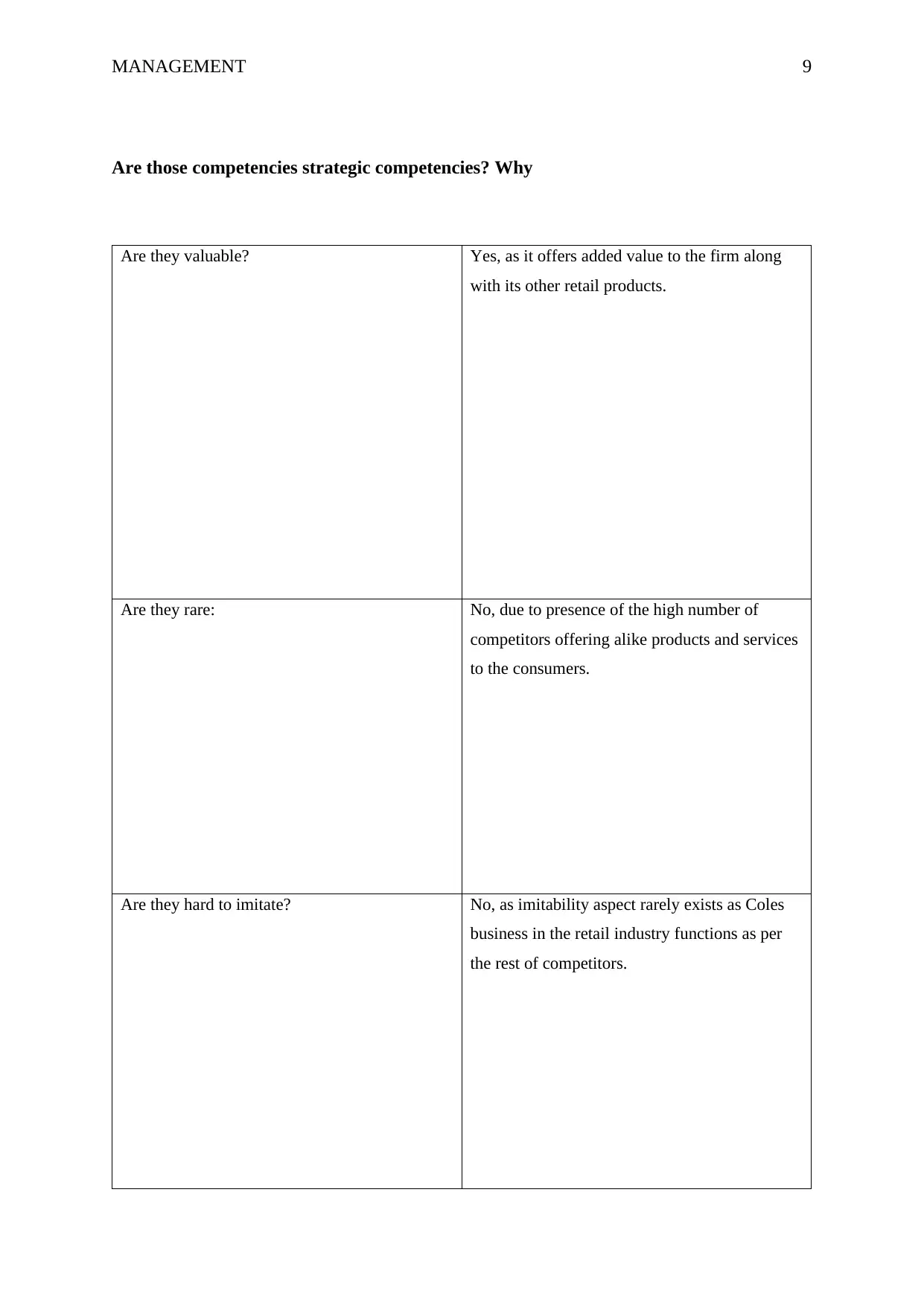
MANAGEMENT 9
Are those competencies strategic competencies? Why
Are they valuable? Yes, as it offers added value to the firm along
with its other retail products.
Are they rare: No, due to presence of the high number of
competitors offering alike products and services
to the consumers.
Are they hard to imitate? No, as imitability aspect rarely exists as Coles
business in the retail industry functions as per
the rest of competitors.
Are those competencies strategic competencies? Why
Are they valuable? Yes, as it offers added value to the firm along
with its other retail products.
Are they rare: No, due to presence of the high number of
competitors offering alike products and services
to the consumers.
Are they hard to imitate? No, as imitability aspect rarely exists as Coles
business in the retail industry functions as per
the rest of competitors.
Paraphrase This Document
Need a fresh take? Get an instant paraphrase of this document with our AI Paraphraser
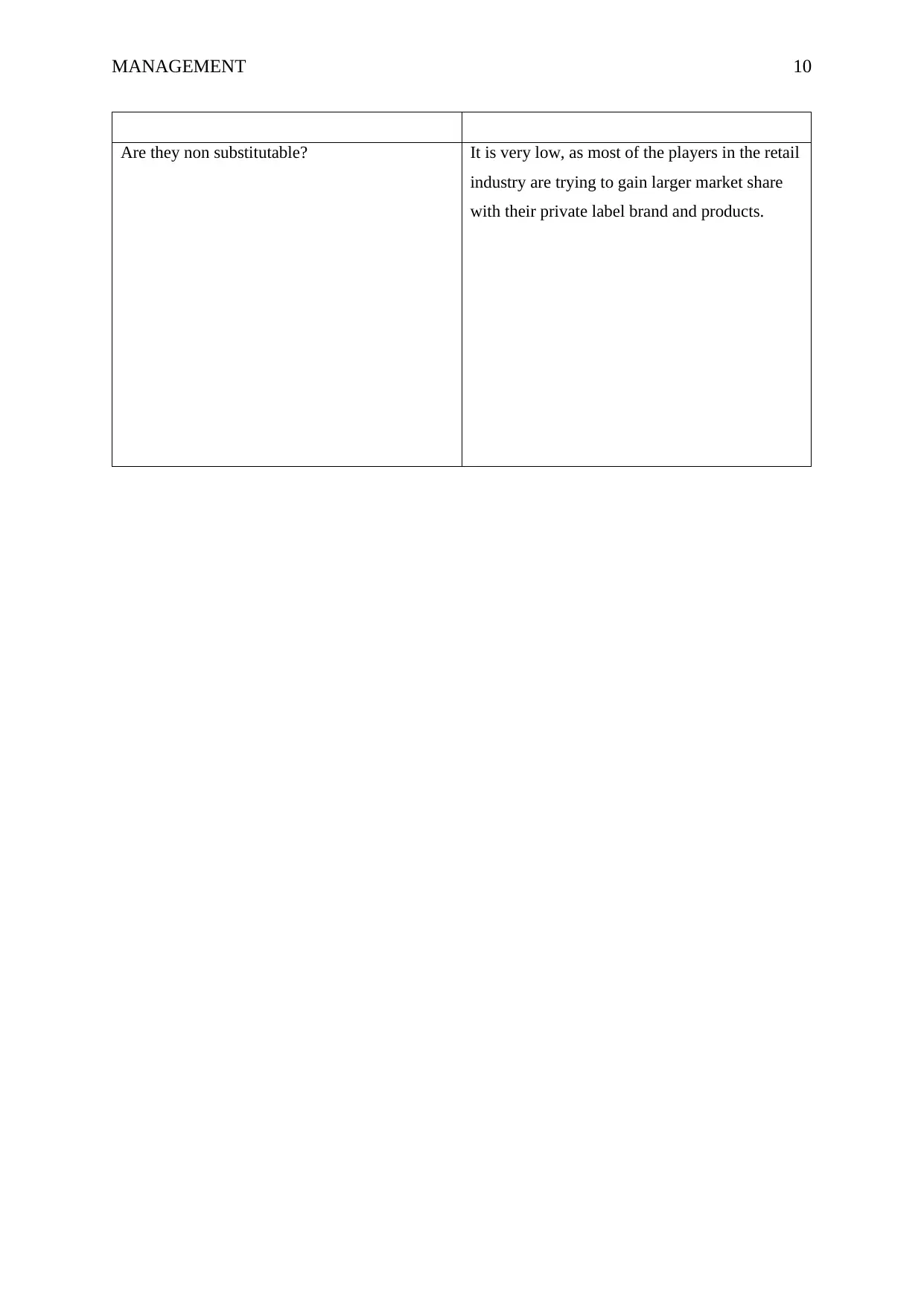
MANAGEMENT 10
Are they non substitutable? It is very low, as most of the players in the retail
industry are trying to gain larger market share
with their private label brand and products.
Are they non substitutable? It is very low, as most of the players in the retail
industry are trying to gain larger market share
with their private label brand and products.
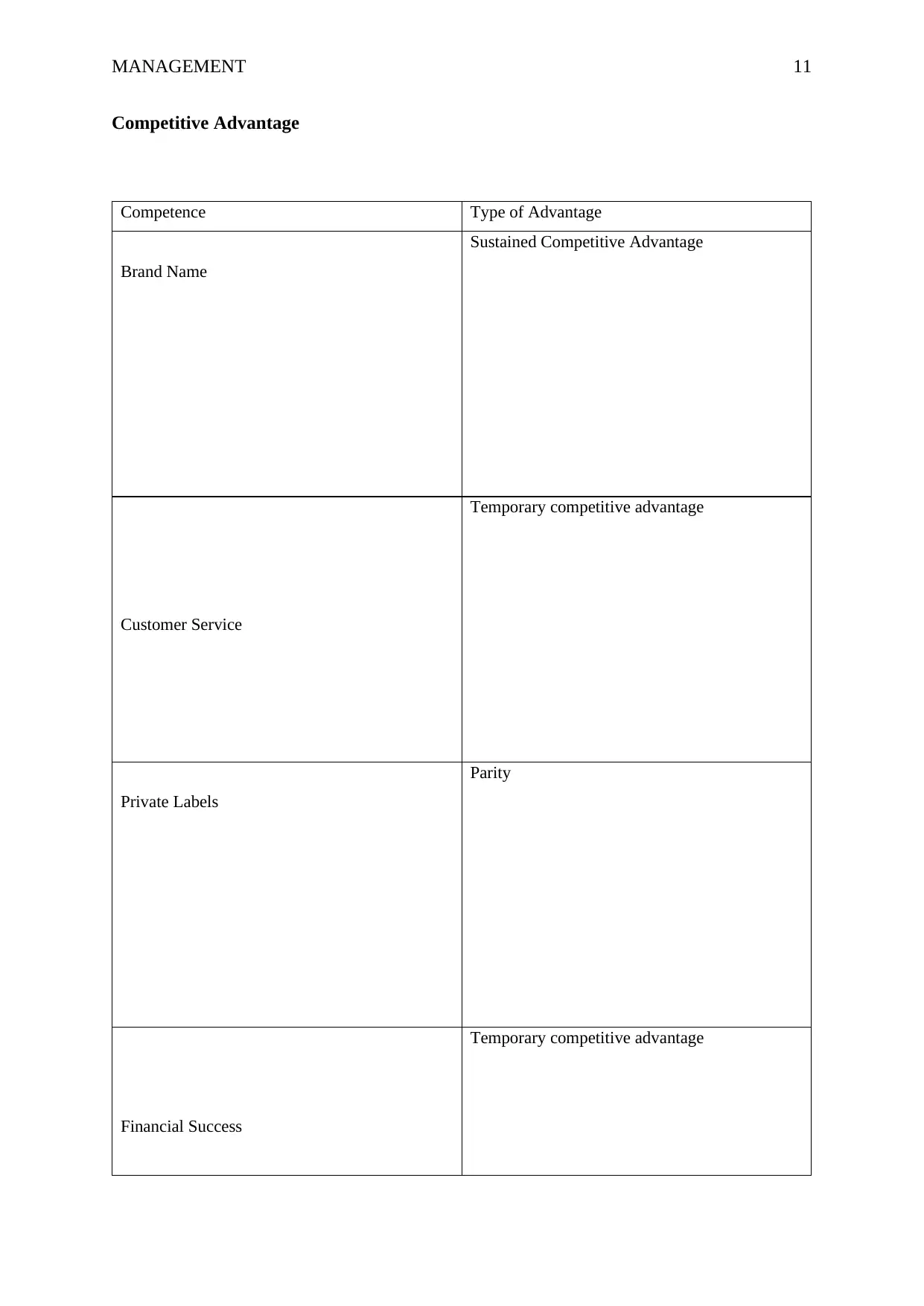
MANAGEMENT 11
Competitive Advantage
Competence Type of Advantage
Brand Name
Sustained Competitive Advantage
Customer Service
Temporary competitive advantage
Private Labels
Parity
Financial Success
Temporary competitive advantage
Competitive Advantage
Competence Type of Advantage
Brand Name
Sustained Competitive Advantage
Customer Service
Temporary competitive advantage
Private Labels
Parity
Financial Success
Temporary competitive advantage
⊘ This is a preview!⊘
Do you want full access?
Subscribe today to unlock all pages.

Trusted by 1+ million students worldwide
1 out of 18
Related Documents
Your All-in-One AI-Powered Toolkit for Academic Success.
+13062052269
info@desklib.com
Available 24*7 on WhatsApp / Email
![[object Object]](/_next/static/media/star-bottom.7253800d.svg)
Unlock your academic potential
Copyright © 2020–2025 A2Z Services. All Rights Reserved. Developed and managed by ZUCOL.




